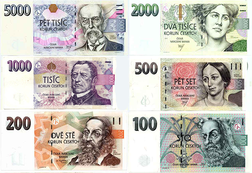Kč
| Czech koruna | |
|---|---|
| koruna česká (Czech) | |

koruna banknotes as of 2014
|
|
| ISO 4217 | |
| Code | CZK |
| Denominations | |
| Subunit | |
| 1⁄100 | haléř (defunct) |
| Plural | The language(s) of this currency belong(s) to the Slavic languages. There is more than one way to construct plural forms. |
| Symbol | Kč |
| haléř (defunct) | h |
| Banknotes | |
| Freq. used | 100, 200, 500, 1000, 2000 Kč |
| Rarely used | 5000 Kč |
| Coins | |
| Freq. used | 1, 2, 5, 10, 20, 50 Kč |
| Demographics | |
| User(s) |
|
| Issuance | |
| Central bank | Czech National Bank |
| Website | www |
| Valuation | |
| Inflation | 2.5% |
| Source | Czech Statistical Office, February 2017 |
| Method | CPI |
The koruna (sign: Kč; code: CZK) is the currency of the Czech Republic since 1993, and in English it is sometimes referred to as Czech crown. The koruna is one of European Union's 11 currencies, and the Czech Republic is legally bound to adopt the euro currency in the future.
The official name in Czech is koruna česká (plural koruny české, though the zero-grade genitive plural form korun českých is used on banknotes and coins of value 5 Kč or higher). The ISO 4217 code is CZK and the local acronym is Kč, which is placed after the numeric value (e.g., "50 Kč"). One koruna equals 100 haléřů (abbreviated as "h", singular: haléř, nominative plural: haléře, genitive plural: haléřů – used with numbers higher or equal to 5 – e.g. 3 haléře, 8 haléřů), but haléře have been withdrawn, and the smallest unit of currency is 1 Kč.
In 1892, the Austro-Hungarian krone replaced the gulden, at the rate of 1 gulden equaling 2 kronen (which is also the reason why the 10-koruna coin is still nicknamed "pětka" or "the five" by the Czechs). The name "krone" was invented by the emperor, Franz Joseph I of Austria. After Austria-Hungary dissolved in 1918, the only successor state that kept the name of the currency, the koruna, was Czechoslovakia. In the late 1920s, the Czechoslovak koruna was the hardest currency in Europe. During the Second World War, the currency on the occupied Czech territory was artificially weakened. The Czechoslovak koruna was restored after the war. It underwent a highly controversial monetary reform in 1953.
...
Wikipedia
